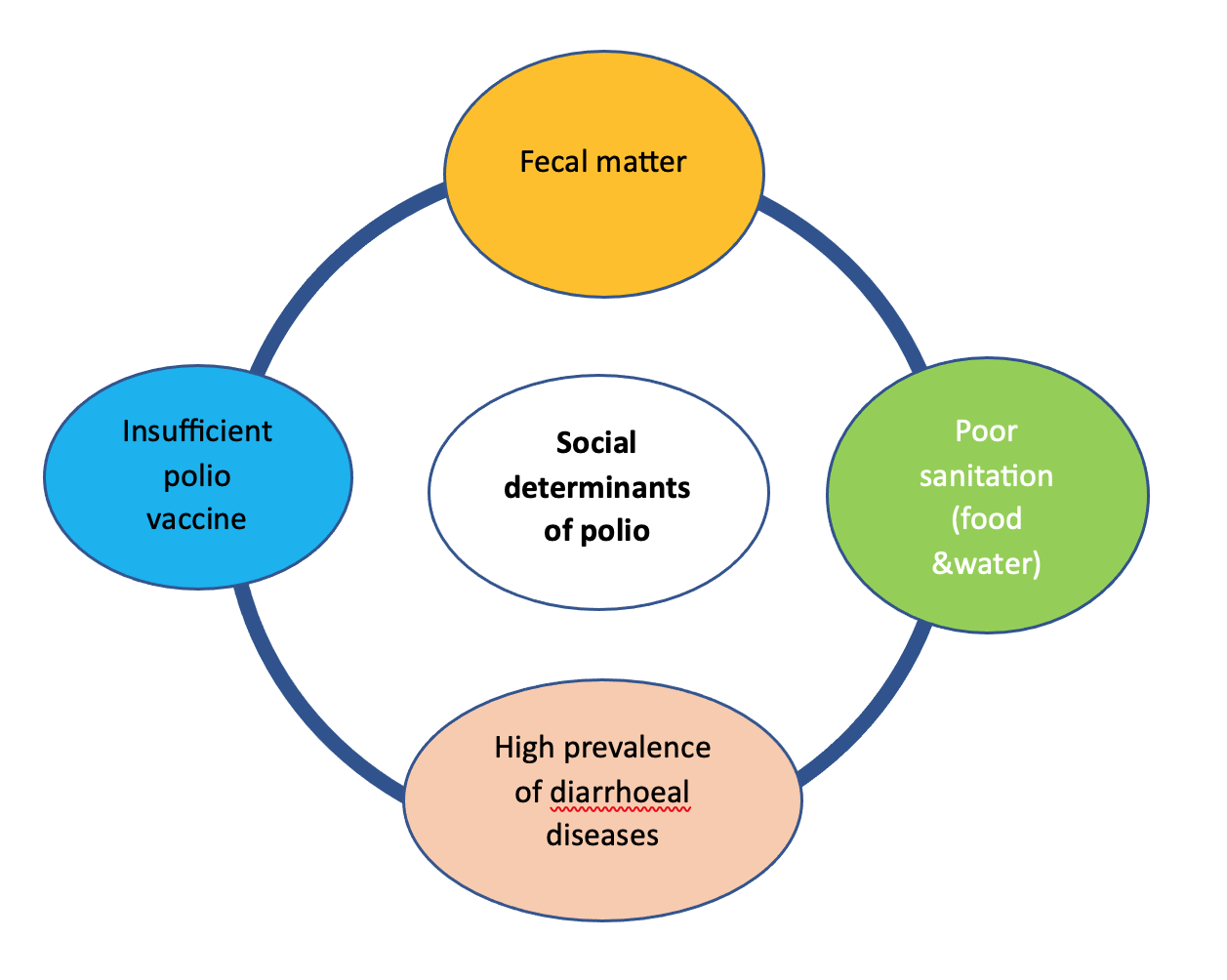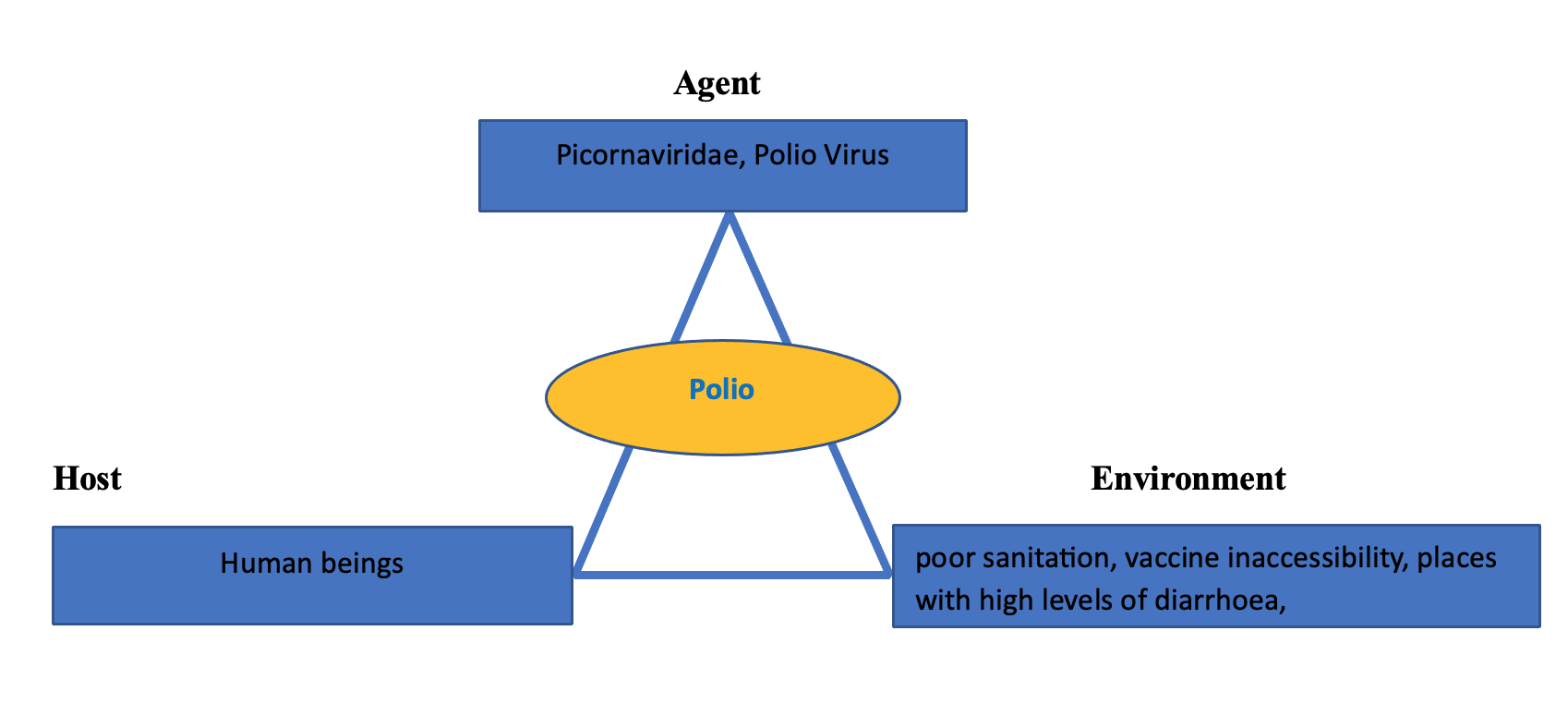Polio: Causes, Symptoms, Mode of Transmission, Complications, Treatment, and The Demographic Of Interest
Polio, also known as poliomyelitis, is a highly contagious disease that paralyzes the body and leads to disability or death. According to the World Health Organization [WHO] (2023), poliovirus is the agent that causes polio. It predominantly affects children below five years of age. Also, it can affect adults who have never been vaccinated.
The Centers for Diseases Control and Prevention [CDC] (CDC, 2022) observes that the infected individuals show no apparent symptoms in most cases. However, 1 in 4 people infected with polio have symptoms such as sore throat, tiredness, fever, headache, stomach pain, and nausea. These symptoms last up to 5 days and disappear on their own.
Polio is transmitted through the direct movement of poliovirus from an infected host to a susceptible host. This can be through feces or, less often, contaminated food and water. The virus multiplies in the intestines. It then attacks the nervous system causing paralysis. The CDC (2023, para. 3) reports that a minority of those with polio infection can develop more severe symptoms, including meningitis and paralysis.
There is no cure for polio. However, prevention and eradication can be achieved through effective public health responses. The best approach to this is through vaccination which helps the host to fight the disease. While polio has one agent that invades a susceptible host, the environment has many factors that should be addressed if the world is to eradicate this disease. For example, polio vaccines should be readily available to infected people. There should be an effort to eliminate myths and misconceptions about polio vaccines which reduce the administration of the vaccine.
In terms of morbidity and mortality, the WHO (2022) reports that 1 out of 200 polio infections leads to permanent paralysis. Out of those who become paralyzed, 5 to 10% die due to crippled respiratory muscles. In addition, wild poliovirus cases have significantly reduced by up to 99% from approximately 350,000 cases in 1988 to only six reported cases as of 2021.
Polio: Reportable Disease
Polio is a highly contagious disease. According to the CDC (2020), paralytic polio case notifications are immediate and extremely urgent. Thus, at the local and state levels, health departments should contact the CDC Emergency Operations Centre within 4 hours to notify the CDC of suspected polio infection. An event code should be sent to 10410 through the National Notifiable Disease Surveillance System (NNDSS). NNDSS monitors, controls, and averts the occurrence and escalation of reportable and notifiable contagious diseases. The CDC (2020) categorizes nonparalytic polio reports as immediately notifiable and urgent. Notification for this should be sent to CDC within 24 hours. The Emergency Operations Center at the CDC (770-488-7100) provides consultation on collecting relevant clinical specimens to be used in virus isolation and subsequent serology.
Social Determinants of Health Impacting Polio
The Office of Disease Prevention and Health Promotion (2020) defines social determinants of health as the circumstances that contribute to or impede the well-being of an individual. Green (2018) asserts that the social determinants of polio include the place of birth, age, living conditions, play, learning environment, worship, and work. The author asserts that health disparities arise due to economic, social, and environmental drawbacks. As such, factors like poor sanitation, contaminated food and water, and healthcare inaccessibility are some of the social determinants that increase the risk of polio. These factors are shown in the diagram below.

Polio Epidemiologic Triangle
In epidemiology, diseases do not occur in a population at random. Some individuals in a population are often more susceptible to infection than others because risk factors may not be randomly distributed. The epidemiologic triangle for polio is a causation model that depicts the components needed for the disease to occur. According to the CDC (2020), polio disease arises when there is an interaction between an agent (in this case, a poliovirus), the susceptible host (human being), and a conducive environment that allows transmission of the agent such as feces and inaccessibility to the polio vaccine.

Special Considerations or Notifications for the Epidemiologic Triangle
The epidemiologic triangle is critical to a community, school, or general population. It helps health workers educate the people on what causes the disease, who can contract it, and the environmental factors that trigger its spread. Information on infectious diseases can be enormous for a community or population. The epidemiological triangle simplifies the complex process of how infectious diseases are caused and spread. It helps health workers break down key constituents of disease transmission.
For epidemiologists, the epidemiologic triangle assists in creating visual representations of available information on a given disease. This helps in framing the relevant public health responses during a disease outbreak.
Importance of Demographic Data to Community Health.
Demographic data is the statistical expression of socioeconomic information such as gender, age, ethnicity, occupation, religion, and nationality. In community health, demographic data is used to assess the health of a given community. Such assessments use primary and secondary data to establish the health of a given society. The analysis of demographic data provides descriptive information on the socioeconomic characteristics of the community. This helps monitor the progress of health-related interventions in a given population to determine their outcomes.
Role of Community Health Nurses
Community health nurses have a valuable role in primary, secondary, and tertiary prevention. In primary prevention, Green (2018) postulates that the community health nurse provides a given population with the necessary knowledge to prevent the outbreak of a targeted disease. The nurse educates and counsels communities to embrace healthy habits and programs. In secondary prevention, the author advances that the nurse participates in disease detection, data collection, and analysis that helps prevent the onset of a disease. Further, in tertiary prevention, the nurse assists in treating existing conditions among patients.
A Christian worldview can be integrated by community nurses when working with a population impacted by polio. Many people are skeptical about Christian approaches to healing and disease management. However, a nurse can incorporate scriptural commendations of mercy and compassion to those who suffer from polio. Nurses have a unique opportunity to respond to polio patients in love while demonstrating their commitment to God. This caring environment promotes the best potential outcomes for populations affected by polio.
National Agency Dealing with Polio
The Global Polio Eradication Initiative (GPEI) was founded in 1988 as a resolution by the World Health Assembly to eradicate Polio (WHO, 2023). The World Health Organization leads the initiative, which is the most significant global public health initiative. This organization has six partners collaborating with national governments in joint efforts to eradicate polio globally. The partners include the World Health Organization (WHO), the US Centers for Disease Control and Prevention (CDC), Rotary International, the United Nations Children’s Fund (UNICEF), Gavi, the Vaccine Alliance, and Bill & Melinda Gates Foundation.
Global Implications of Polio
The WHO (2022) contends that as long as a single child remains infected with polio, all other children across the globe are at risk of infection. The inability to eradicate polio in the remaining hotspot countries can lead to a worldwide resurgence of polio. For instance, there has been an increase in the cases of wild poliovirus in Pakistan. Visram (2017) observes that health teams could not access children in militant-controlled areas. In these areas, polio was endemic, and health workers became a target of the militants. However, the vaccine teams created innovative strategies to reach the high-risk areas through awareness campaigns championed by enlightened community members such as religious clerics.
References
Centers for Disease Control and Prevention. (January 9, 2023). What is Polio? https://www.cdc.gov/polio/what-is-polio/index.htm
Centers for Disease Control and Prevention. (2022). Community Health Assessment: Data & Benchmarks. https://www.cdc.gov/publichealthgateway/cha/data.html
Centers for Disease Control and Prevention. (September 23, 2020). Manual for the Surveillance of Vaccine-Preventable Diseases. https://www.cdc.gov/vaccines/pubs/surv-manual/chpt12-polio.html
Office of Disease Prevention and Health Promotion. (2020). Social Determinants of Health. Social Determinants of Health – Healthy People 2030 | health.gov
Green, Sue, Z. (2018) Social Determinants of Health. https://lc.gcumedia.com/nrs427vn/community-and-public-health-the-future-of-health-care/v1.1/#/chapter/2
Green, Sue, Z. (2018). Today’s Community and Public Health Nurses. https://lc.gcumedia.com/nrs427vn/community-and-public-health-the-future-of-health-care/v1.1/#/chapter/1
Visram, Alina, A. (October 24, 2017). Overcoming obstacles to polio eradication in Pakistan.
World Health Organization. (2022) Poliomyelitis: Key facts https://www.who.int/news-room/fact-sheets/detail/poliomyelitis
World Health Organization. (2023). Poliomyelitis (Polio). https://www.who.int/health-topics/poliomyelitis#tab=tab_3
World Health Organization. (2023). Polio Eradication Initiative. https://www.emro.who.int/polio-eradication/about-eradication/index.html
 write
write